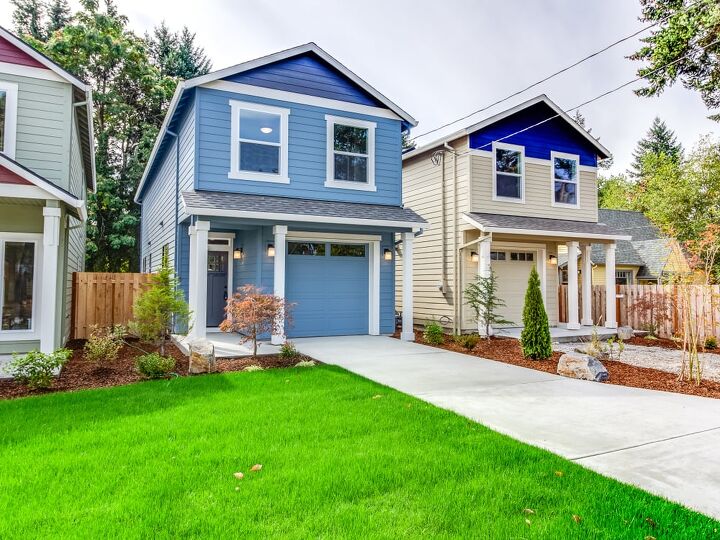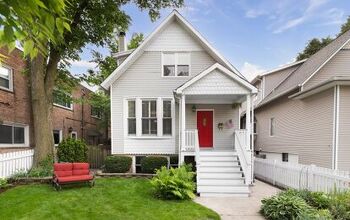15-Ft Wide House Plans (with Drawings)

When you think of a 15-ft wide house, you might picture a shotgun house or single-wide mobile home. These style homes are typically long and narrow, making them a good fit for narrow lots. You could also find multi-level 15-ft wide homes in many cities, where space is limited, but housing needs are high.
Although the lot determines the depth of a 15-ft wide house, it can typically range from about 15 to 80 feet. A 15′ x 15′ house would squarely plant you in the tiny living community, even with a two-story. But, if you had a two-story, 15-ft wide home that’s 75 feet deep, you’d have up to 2,250 square feet.
As you can see, 15-feet wide doesn’t necessarily mean small; it just means narrow. It certainly presents some challenges when it comes to layout, but it also provides unique opportunities.
Reasons For Living In A 15-Foot Wide House
If you’re building a 15-ft wide house, you probably have to because of the available lot size. Another reason could be you’re opting for a tiny house to keep costs down or live a simpler lifestyle. Or perhaps you’re placing a mobile home on a plot of land, and your new single-wide spans 15 feet.
If you’re buying a home in the city, you might find your only options are narrow houses. Some could be detached houses or shotgun homes, while others are part of multi-dwelling units, like a duplex or fourplex.
Regardless of why you have a 15-ft house, you’ll face similar pros and cons concerning the width.
The Pros Of A 15-Foot House
- You can achieve a roomy home on a narrow lot since you can always build-up compared to building out. This lets you build in more places.
- Having a narrow home encourages creativity and imagination with the design.
- Typically, narrow houses are on narrow lots, which means less yard maintenance and fewer costs.
The Cons Of A 15-Foot House
- Depending on how you layout the rooms, some rooms can be long and narrow. This shape can be a challenge to design.
- You won’t be able to get an overly spacious open floor plan. Although, you can have more open shared spaces if you build up and place bedrooms upstairs.
- An overly narrow house might force you to walk through certain rooms (like bedrooms) to reach others. This is a common occurrence in many shotgun houses.
If you find a 15-foot wide house is in your future, take your time with the design. Start with the necessities and go from there based on your available square footage.
Essentials would be things like a kitchen area, bathroom, and a place to sleep. You also need to consider how many people will live in the home and the future potential to add on.
For example, if you have a 15-foot wide home in the city, you can likely build up in the future. However, in some areas, zoning restrictions might cap you at two stories.
A Single-Story 15-Foot Wide House
Assume you have an overall depth of just over 40 feet in a single-story, 15-ft wide house. This gives you just over 600 square feet to work with. With this space, since you’ll want a kitchen, bathroom, and living area, you’ll likely fit one decent-sized bedroom.
In this example, the kitchen is somewhat separated from the living room. However, instead of a wall next to the living area, you could do a half-wall and bar-height counter. Or you could remove the wall and add an island to open up the space.
The master bedroom is at the back of the house to maximize privacy. A centrally-located bathroom makes it easy to access, and a front porch extends the usable space.
A Two-Story 15-Ft Wide House
If you can add on and build up, then a two-story 15-ft wide house enables you to add some extras. You might opt for extra bedrooms and bathrooms or something like a home office.
In this example, this 15-foot home is an ample 80 feet deep. Depending on how you set up your livable space, it can offer roughly 2,400 square feet.
This home features only shared spaces downstairs, allowing for a roomier kitchen and living area. Plus, the dining and living combo leads into a more open kitchen, helping the whole area feel larger. There’s also room for a garage at the back of the house.
Upstairs has space for a master retreat and two nice-sized bedrooms, plus an extra bathroom and a laundry room.
15-Foot Houses In A Multi-Dwelling
You’ll also find many 15-foot wide homes in multi-dwelling units, like fourplexes and triplexes. These buildings typically feature several narrow homes in a row or within one building.
This fourplex is 32 feet deep by 60 feet wide, divided into 4 separate 15-foot wide homes. Each unit provides two floors, with an overall square footage of roughly 919. Two bedrooms are upstairs, with the lower level encompassing a living/dining area, kitchen, and walk-out patio.
To save space, a washer and dryer closet is also upstairs, along with an extra bathroom.
Source: “ 4-Plex Plans: F-552” by houseplans.pro
How Should You Size Rooms in a 15-Foot Wide House?
The rooms in a 15-ft wide house could have a similar area to rooms in a wider home. However, they will likely have far different dimensions, being longer and narrower. Or, you may end up with rooms slightly smaller than in a wider home.
Regardless, your total square footage should play a role in how you allocate your room sizes. Builders typically designate a certain percentage of a home’s overall square footage to each room.
You can use these percentages to give you a rough idea of individual room sizes. But, if a particular room equals 125 square feet, it could end up being 8 feet wide by 16 feet long. This could be a designer’s dream (if they love a challenge) or nightmare.
According to the National Association of Home Builders, these percentages vary based on your home’s size. The percentages look at small homes (under 2,000 sqft) and large homes (over 3,500 sqft).
These examples will look at a small, single-story 15-ft wide house that is 30-ft deep and totaling 450 square feet. You’ll notice this particular size won’t have as many room options as the other examples.
Next, an average-sized, two-story 15-ft by 60-ft home, totaling 1,800 square feet. And, finally, a larger 15-ft wide home, measuring 80-feet deep and two stories, for a grand total of 2,400 square feet.
Based on the recommended percentages, your room spacing might look something like this.
Average Space Allocation in a Single-Story 15′ x 30′ Home | ||
| Room | Percentage of Square Footage | Total Square Footage |
| Bedroom/Sleeping Areas | 29.8% | 134.0 sqft |
| Bathroom/Bathrooms | 11.4% | 51.3 sqft |
| Kitchen Area | 14.7% | 66.2 sqft |
| Breakfast Nook/Eat-In Area | 3.1% | 14.0 sqft |
| Living Room Area | 24.3% | 109.4 sqft |
| Laundry Area | 3.5% | 15.7 sqft |
| Other Finished Spaces/Storage Areas | 13.2% | 59.4 sqft |
| TOTAL | 100% | 450 sqft |
Average Space Allocation in a Two-Story 15’ x 60’ Home | ||
| Room | Percentage of Square Footage | Total Square Footage |
| Master Bedroom | 13.1% | 235.8 sqft |
| All Other Bedrooms | 16.7% | 300.6 sqft |
| Master Bathroom | 6.5% | 117.0 sqft |
| All Other Bathrooms | 4.9% | 88.2 sqft |
| Kitchen | 12.7% | 228.6 sqft |
| Breakfast Nook/Eat-In Area | 3.1% | 55.8 sqft |
| Dining Room/Living Room | 16.1% | 289.8 sqft |
| Family Room/Library/Etc. | 9.9% | 178.2 sqft |
| Laundry Room | 3.5% | 63.0 sqft |
| Entry/Foyer | 2.5% | 45.0 sqft |
| Other Finished Spaces | 11.0% | 198.0 sqft |
| TOTAL | 100% | 1,800 sqft |
Average Space Allocation in a Two-Story 15’ x 80’ Home | ||
| Room | Percentage of Square Footage | Total Square Footage |
| Master Bedroom | 13.1% | 314.4 sqft |
| All Other Bedrooms | 16.7% | 400.8 sqft |
| Master Bathroom | 6.5% | 156.0 sqft |
| All Other Bathrooms | 4.9% | 117.6 sqft |
| Kitchen | 12.7% | 304.8 sqft |
| Breakfast Nook/Eat-In Area | 3.1% | 74.4 sqft |
| Dining Room/Living Room | 16.1% | 386.4 sqft |
| Family Room/Library/Etc. | 9.9% | 237.6 sqft |
| Laundry Room | 3.5% | 84.0 sqft |
| Entry/Foyer | 2.5% | 60.0 sqft |
| Other Finished Spaces | 11.0% | 264.0 sqft |
| TOTAL | 100% | 2,400 sqft |
Obviously, you can tweak these numbers to accommodate your specific lifestyle. However, this provides you a general idea of room sizes that would work in a 15-ft wide house.
Related Questions
Are there special restrictions to consider if you build a small house?
It all depends on where you’re building. In some states, the building code states a home must be a specific minimum size, which can vary greatly. For example, some states require new homes to be at least 1,000 square feet. In other cases, there may be stipulations on room sizes and so forth. If you’re planning to build a new house, it’s vital to know the local building codes no matter the size. Ensure you work with a reliable and professional contractor that will stay on top of all code restrictions and permits.
How wide is a single-wide mobile home?
On average, a single-wide mobile home is roughly 18 feet wide. But this number varies, ranging from 14 to 18 feet.The typical depth of a single-wide averages 66 to 80 feet. You can expect about 500 to 700 square feet in a smaller single-wide mobile home. Meanwhile, larger ones can surpass 1,200 square feet and have more bedrooms and bathrooms.In comparison, double-wides range between 36 and 42 feet wide. Some are only about 27 or 28 feet deep, while others are more than 75 feet long.

Stacy Randall is a wife, mother, and freelance writer from NOLA that has always had a love for DIY projects, home organization, and making spaces beautiful. Together with her husband, she has been spending the last several years lovingly renovating her grandparent's former home, making it their own and learning a lot about life along the way.
More by Stacy Randall





























![Standard Dining Room Table Dimensions [for 4, 6, 8, 10 and 12 People]](https://cdn-fastly.upgradedhome.com/media/2023/07/31/9074335/standard-dining-room-table-dimensions-for-4-6-8-10-and-12-people.jpg?size=350x220)

